, Iacopo Dallan1 and Manfred Tschabitscher2
(1)
Department of Otorhinolaryngology, University of Insubria, Ospedale di Circolo e Fondazione Macchi, Varese, Italy
(2)
Medical University of Vienna, Vienna, Austria
Abstract
This chapter illustrates the surgical anatomy of the cervical portion of the internal carotid artery. This tract of the vessel starts from the common carotid artery bifurcation and ends at the level of the skull base; therefore, it is identifiable as the extracranial portion of the internal carotid artery. A careful description of the anatomic relationship between the artery and all the neural, muscular, and vascular structures of the neck is provided. The exposition is really surgically oriented and can be of valuable help for many surgeons, especially for those who perform advanced endoscopic endonasal surgery.
1.1 Anatomic Layout
The cervical segment of the internal carotid artery (ICA) starts in the neck at the common carotid artery (CCA) bifurcation and ends at the level of the carotid foramen. This segment is both extradural and extracranial. Conventionally, the cervical ICA can be divided into a proximal and distal part. The border between the two segments is not universally accepted. In this atlas, we assumed that the proximal segment extends from the carotid bifurcation to the point where the vessel is crossed by the posterior belly of the digastric muscle, and the distal segment is from this point to the entrance of the vessel into the carotid canal. These external landmarks are virtually useless when describing ICA anatomy from an anterior, endoscopic perspective.
1.1.1 Proximal Segment
At the level of the neck, the proximal part of the ICA usually presents a vertical course and a strict relationship with the internal jugular vein (IJV) and the vagus nerve. Usually, the carotid bifurcation is localized at the level of the upper border of the thyroid cartilage. Close to this, it is possible to visualize the carotid sinus, a localized area of dilation, and the carotid body (glomus caroticum). The last is appreciable on the posteromedial wall of the carotid bifurcation. Above the bifurcation, the ICAp (parapharyngeal portion of the ICA) ascends under the sternocleidomastoid muscle. This portion of the vessel presents, on its lateral surface, a critical relationship with the hypoglossal nerve, which courses along the inferior border of the posterior belly of the digastric muscle and goes toward the tongue. Above this level, the ICAp is crossed by the occipital artery (Janfaza and Fabian 2001a, b). More inferiorly, the ansa hypoglossi runs on the anterolateral surface of the CCA. The vagus nerve is placed deep between the CCA/ICA and the IJV, and it is enclosed in the carotid sheath while the accessory nerve runs beneath the most posterior aspect of the posterior belly of the digastric muscle, in 2/3 of the cases over the IJV and in 1/3 below, moving posteriorly and inferiorly toward the anterior border of the sternocleidomastoid muscle (Janfaza and Fabian 2001a, b). In more than 80 %, it passes through the sternocleidomastoid muscle (Janfaza and Fabian 2001a, b). Anteriorly to the ICA, the superior laryngeal nerve can be visualized. In more detail, the nerve can be identified in between the external carotid artery (ECA), stylohyoid muscle, and the superior thyroid artery, with which it usually maintains a close relationship. On its medial surface, the ICAp presents a close relationship with the superior constrictor muscle and to some extent to the tonsillar fossa.
1.1.2 Cranial Segment
Cranial to the posterior belly of the digastric muscle, the ICA is covered and separated from the ECA by the styloid apparatus. The ECA is located anterolaterally to the ICA. With a lateral perspective, the stylohyoid muscle is the first muscle encountered; the stylopharyngeus muscle is the most medial. The styloglossus lies in between and anterior to the other two muscles. Below the inferior part of the styloid process, the glossopharyngeal nerve can be visualized. It lies medial to the styloid process and lateral and in close proximity to the stylopharyngeus muscle. The nerve courses in a posterior-to-anterior direction, first posterior to the stylopharyngeus muscle and then lateral and anterior to it. At the end, it runs medially, innervating the pharyngeal wall muscles. Usually, the glossopharyngeal nerve is accompanied by the pharyngeal branch(es) from the vagus nerve. The glossopharyngeal nerve can be identified in a triangle given by the styloglossus/stylopharyngeus, the ECA, and the facial artery (Cavalcanti et al. 2010). At this level, the ICA is “covered” by a thick fascia, stylopharyngeal aponeurosis, connecting the posteromedial surface of the styloid process to the pharyngeal recess (Rhoton 2000). This fascia separates the carotid space (previously named the poststyloid compartment) from the prestyloid compartment, and belongs to the styloid diaphragm. More exactly, it represents its medial aspect. Anatomically speaking, the styloid diaphragm is given by the posterior belly of the digastric muscle, stylohyoid, stylopharyngeus, and stylopharygeal aponeurosis.
Posteriorly, the ICA presents a close relationship with the longus capitis muscle (in its lateral aspect), the superior sympathetic chain and ganglion, the vagus nerve, and to some extent the IJV. At this level (more or less C1), the “jugular” and hypoglossal nerves pass between the ICA and the IJV (Janfaza and Fabian 2001a, b). The superior cervical ganglion lies on the longus capitis muscle, medial to the vagus nerve and within a duplication of the prevertebral fascia, at the C2–3 level. After its exit from the jugular foramen (JF), the IJV initially lies on the rectus capitis lateralis muscle, crosses the transverse process of C1, and then presents an anterior and lateral position with respect to the transverse processes of the other vertebrae. Going inferiorly, it becomes lateral to the ICA/CCA and lies on the surface of the levator scapulae and middle and anterior scalene muscles. Superiorly and laterally, it is separated from the parotid gland by the stylopharyngeus muscle and the styloid process. The vagus nerve remains behind and somewhat between the vessels during its pathway. The accessory nerve runs inferiorly as the most posterior of the three nerves, crossing the IJV (in 2/3 of the cases, above the IJV). It presents a strict relationship with the transverse process of C1. The hypoglossal nerve, once it exits from its own foramen, comes in close relationship with the IX, X, and XI cranial nerves. It lies medial to the IJV and ICA and passes laterally and inferiorly, together with the sympathetic trunk, between the IJV and ICA. At the level of the transverse process of C1, it turns anteriorly on the lateral surface of the ICA, and then it curves around the occipital artery and runs first to the lateral and then to the anterior surface of the ECA. Inferiorly, it lies lateral to ICA and ECA and deep to the styloid process.
1.1.3 Jugular Foramen Region
Anatomically speaking, the JF does not correspond to a single hole but is a canal given by the basioccipital bone (posteromedially) and the petrous bone (anterolaterally) (Rhoton 2003; Roche et al. 2008). Within the JF, three compartments can be described: a large posterolateral venous channel (sigmoid); a small anteromedial venous compartment (petrosal), which receives the drainage of the inferior petrosal sinus (IPS); and an intermediary neural compartment (intrajugular), located between the venous ones (Katsuta et al. 1997; Rhoton 2003).
The anterior or petrosal compartment is given by a small venous channel that receives the IPS. The relationship with the IPS is highly variable. This sinus drains into the anterior aspect of the jugular bulb in more than 90 % of cases (Roche et al. 2008); in less than 10 % of cases, it drains directly into the IJV. Sometimes, a poorly developed IPS has connection with the plexus of the hypoglossal canal (also named the anterior condylar vein), the petroclival vein, or the posterior condylar emissary vein. This last vein puts the vertebral venous plexus into communication with the jugular bulb (Roche et al. 2008).
The medial intrajugular compartment includes neural structures, venous channels, and arterial vessels. The glossopharyngeal nerve is separated from the vagus and accessory nerve by means of a dural fold (dural septum) and a venous channel. If the dural fold is ossificated it is called Hayek’s bridge. The glossopharyngeal nerve, when it exits through the JF, forms a superior and inferior ganglion. The inferior ganglion is placed in a small fossa, the fossula petrosa, placed between the carotid canal and the jugular foramen. Then, the nerve courses along the posteromedial aspect of the ICA; at the level of the skull base, it gives the Jacobson’s nerve, which enters its own canaliculus (canaliculus tympanicus) to reach the middle ear (Lang 1995; Osawa et al. 2008). Then, the nerve, after giving some anastomotic branches for cranial nerve X, runs on the lateral surface of the ICA and buries itself within the vagina carotica, coursing anteriorly and inferiorly to the vessel. At the level of the inferior ganglion, there are some twigs that anastomose with similar ones from the vagus nerve and from the sympathetic chain to form the ramus sinus carotici of Hering.
The vagus nerve enters the dura through the vagal meatus (Rhoton 2003), and it is immediately joined by the accessory nerve. Immediately lateral to the intrajugular process of the temporal bone, the superior ganglion lies. At this level, the vagus nerve branches off the Arnold nerve (auricular branch), which enters a mastoid canaliculus and goes toward the third part of the facial nerve. When the vagus nerve emerges from the superior ganglion, it passes posteriorly to the carotid sheath together with the accessory nerve. The inferior ganglion is located anterior to the transverse process of C1–C2. At this level, a small pharyngeal branch arises, which connects with the pharyngeal branch of cranial nerve IX. Below this, the superior laryngeal nerve arises.
The accessory nerve lies immediately lateral to the vagus nerve and presents a close relationship with it. It divides into 2 rami at the JF. The internal one (accessory ramus of the vagus nerve) joins the vagus nerve just below the JF, while the external one acts as the accessory nerve for trapezius and sternocleidomastoid muscle. Both nerves (accessory and vagus) are posterior to the glossopharyngeal nerve. Below the JF, usually they are on the posteromedial wall of the IJV. Obviously, the nerve position can be different with respect to the IJV. In about 60 %, the nerve is anterior to the IJV; in the remaining cases, it is behind the IJV. Rarely, it can run through the connecting vein between the IPS and the IJV and then course dorsal to the styloid process.
The posterior compartment is occupied by a wide venous channel that drains the sigmoid sinus. It is mainly given by the superior jugular bulb, which is housed in the jugular fossa. Usually the posterior meningeal artery enters this space.
Anatomically speaking, the hypoglossal nerve does not belong to the JF, but given its close relationship, it is included in a description of the JF region. The exit point of the hypoglossal nerve is medial and below the JF. The nerve exits from the anterior condylar foramen and lies posterior to IX, X and XI cranial nerves and on the medial surface of the IJV. Then, it passes laterally between the IJV and the ICA (through the carotid sheath) (Janfaza et al. 2001). So, from an anatomic viewpoint, the hypoglossal nerve does not transverse the JF but joins the “jugular” nerves just below the skull. At the level of the transverse process of C1, it turns frontward, lying on the lateral surface of the ICA.


Fig. 1.1
Infratemporal fossa-osteology
FO foramen ovale, LPP lateral pterygoid plate, OC occipital condyle, TM tuberosity of the maxilla, ZA zygomatic arch, black asterisk glenoid fossa, blue spine of the sphenoid, yellow pterygopalatine fissure, red inferior orbital fissure, red arrow styloid process
1.2 Anatomic Pictures
The pterygomaxillary fissure is a narrow V shaped fissure between the LPP and the superior portion of the tuberosity of the maxilla. The upper part of the pterygomaxillary fissure joins the inferior orbital fissure. The pterygo-palatine fossa communicates with the infratemporal fossa (ITF) by means of the pterygomaxillary fissure laterally. Behind the inferior orbital fissure lies the ITF, which is mainly located below the greater wing of the sphenoid.
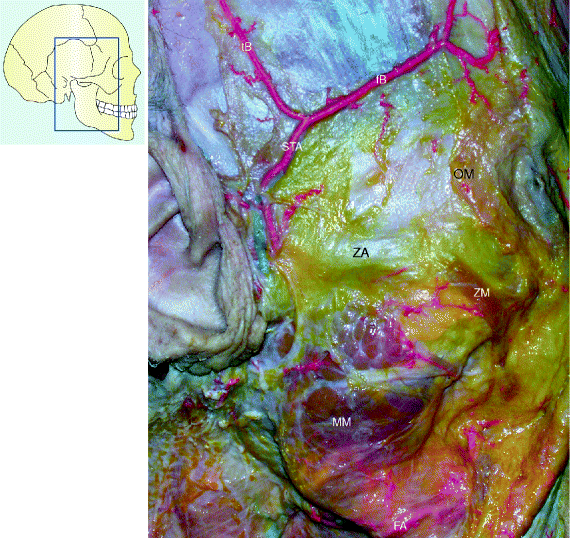

Fig. 1.2
Lateral vision of the temporozygomatic region
FA facial artery, fB frontal branch, MM masseter muscle, OM orbicularis oculi muscle, STA superficial temporal artery, tB temporal branch, ZA zygomatic arch, ZM zygomatic muscle
The parotid-masseteric fascia covers the masseteric muscle and surrounds the parotid gland. It attaches superiorly to the zygomatic arch and extends deep to the posterior border of the ramus of the mandible, fusing with the fascia of the posterior belly of the digastric muscle, to give the stylomandibular ligament (Janfaza and Fabian 2001b).
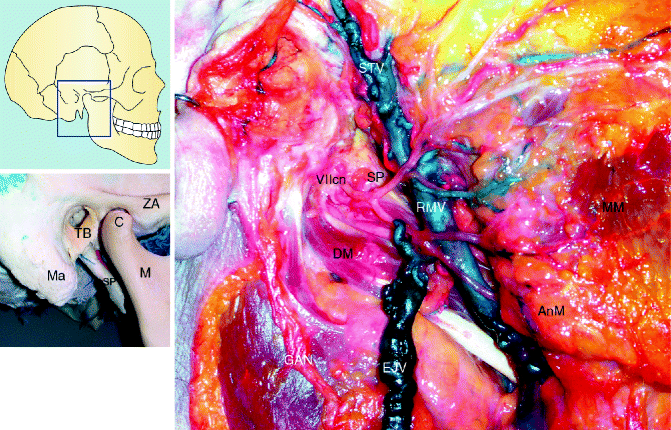

Fig. 1.3
Lateral vision of the parotid-cervical region. The facial nerve has been dissected and the parotid gland removed
AnM angle of the mandible, C condyle, EJV external jugular vein, GAN greater auricular nerve, M mandible, Ma mastoid, MM masseter muscle, RMV retromandibular vein, SP styloid process, STV superficial temporal vein, TB tympanic bone, ZA zygomatic arch, VIIcn facial nerve
The maxillary vein joins the superficial temporal vein in the parotid gland, forming the RMV. The facial nerve lies lateral to the RMV.
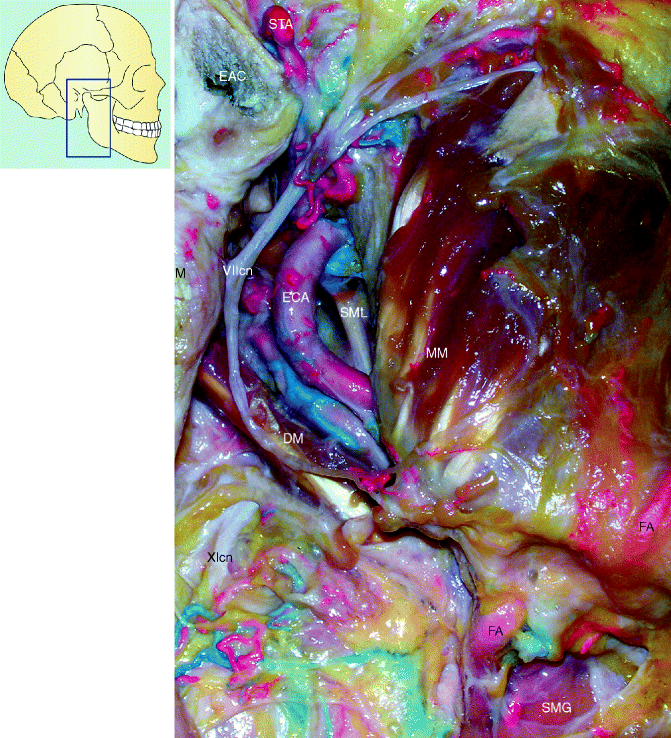

Fig. 1.4
Parotid fossa. The parotid gland has been removed and the deeper areas exposed
DM digastric muscle (posterior belly), EAC external acoustic canal, ECA external carotid artery, FA facial artery, M mastoid, MM masseter muscle, SMG submandibular gland, SML spheno-mandibular ligament, STA superficial temporal artery, VIIcn facial nerve, XI accessory nerve
The parotid-masseteric fascia covers the masseteric muscle and splits to involve the parotid gland. Deeply and posteriorly, it fuses with the fascia of the digastric muscle to give the stylo-mandibular ligament.
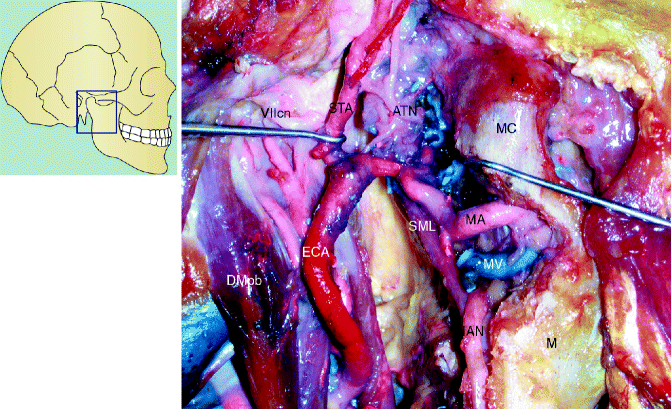

Fig. 1.5
Parotid region. The inferior part of the neck of the mandibular condyle has been partially removed
ATN auriculotemporal nerve, DMpb posterior belly of the digastric muscle, ECA external carotid artery, IAN inferior alveolar nerve, M mandible, MA maxillary artery, MC mandibular condyle, MV maxillary vein, SML sphenomandibular ligament, STA superficial temporal artery, VIIcn facial nerve
The MA enters the infratemporal fossa, passing between the mandibular condyle and the SML. At this level, it usually lies below the ATN and above the MV. Usually, it passes lateral to the nerves, and only in less than 5 % of cases it is deep to all the branches of V3. Only the first part of the MA is accompanied by the MV, the second and third parts are accompanied by a venous plexus. The MV(s) unite with the superficial temporal vein to form the retromandibular vein. The ATN emerges from the upper border of the parotid gland behind the temporomandibular joint and then runs over the root of the zygomatic arch posterior to the STA.
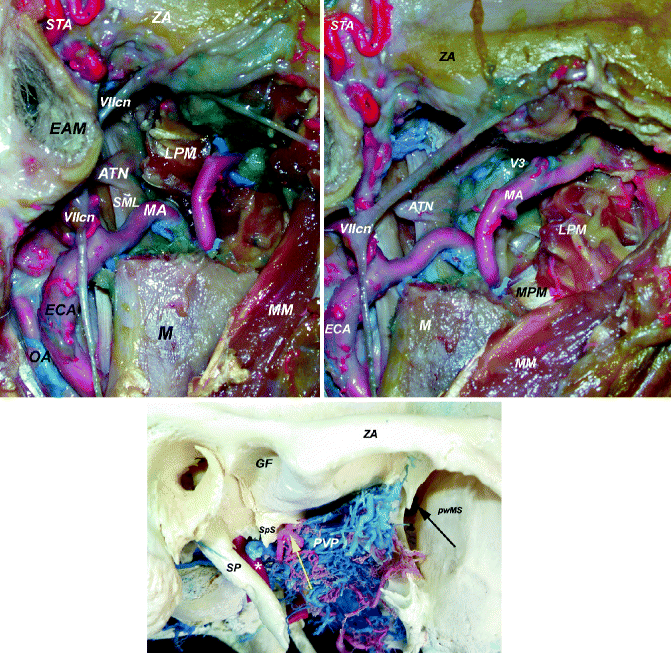

Fig. 1.6
Infratemporal fossa exposure. The condyle and the neck of the mandible have been removed
ATN auriculotemporal nerve, EAM external acoustic meatus, ECA external carotid artery, GF glenoid fossa, LPM lateral pterygoid muscle, M mandible, MA maxillary artery, MM masseter muscle, MPM medial pterygoid muscle, OA occipital artery, pwMS posterior wall of the maxillary sinus, PVP pterygoid venous plexus, SML sphenomandibular ligament, SP styloid process, SpS spine of the sphenoid, STA superficial temporal artery, ZA zygomatic arch, V3 third branch of the trigeminal nerve, VIIcn facial nerve, black arrow pterygopalatine fossa, yellow arrow middle meningeal artery, white asterisk parapharyngeal portion of the internal carotid artery
The infratemporal fossa communicates medially with pterygopalatine fossa and posteromedially with the parapharyngeal space. The MA is 1 of the 2 terminal branches of the ECA; the other is the STA. During its course within the infratemporal fossa, its relationship with the LPM is highly variable. The PVP lies between temporalis, lateral, and medial pterygoid muscles (Janfaza and Montgomery 2001). PVP can comunicate directly with the cavernous sinus through Foramen of Vesalius (when it is present). The pterygoid fascia encases both pterygoid muscles and attaches to the stylomandibular ligament. The sphenomandibular ligament is a fascial condensation between the spine of the sphenoid and the lingula of the mandible (Janfaza and Fabian 2001).


Fig. 1.7
Parotid and retrocondylar region
ATN auriculotemporal nerve, IAN inferior alveolar nerve, LPM lateral pterygoid muscle, M mandible, MA maxillary artery, MMA middle meningeal artery, MV maxillary vein, PDTA posterior deep temporal artery, PDTV posterior deep temporal vein, SML sphenomandibular ligament, TM temporal muscle
Usually, the MMA is posterior to the lateral pterygoid muscle. The ATN passes laterally, around the MMA and between the neck of the mandible and the SML. Similarly, the IAN passes inferiorly between the neck of the mandible and the SML. This last one is a thin fibrous connection between the spine of the sphenoid and the lingula of the mandible (Janfaza et al. 2001). Sometimes, there is an accessory middle meningeal artery that can share a common trunk with the MMA. It accompanies the mandibular nerve and enters the cranial cavity through the foramen ovale.
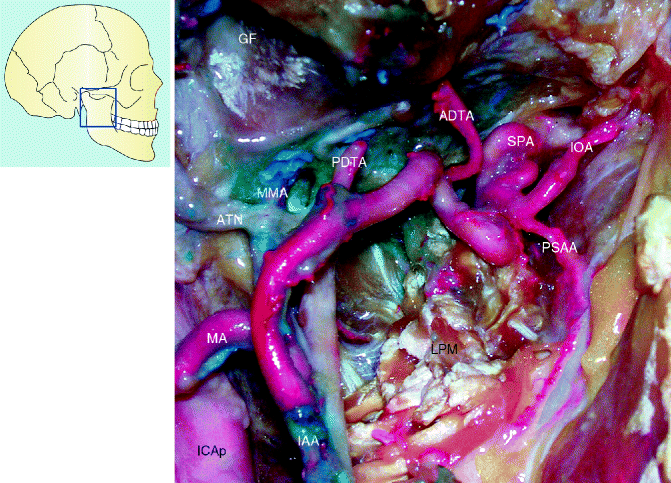

Fig. 1.8
Infratemporal fossa exposure, focus on the maxillary artery
ADTA anterior deep temporal artery, ATN auriculotemporal nerve, GF glenoid fossa, IAA inferior alveolar artery, ICAp parapharyngeal portion of the internal carotid artery, IOA infraorbital artery, LPM lateral pterygoid muscle, MA maxillary artery, MMA middle meningeal artery, PDTA posterior deep temporal artery, PSAA posterosuperior alveolar artery, SPA sphenopalatine artery
The first small branches of the MA are the deep auricular and anterior tympanic arteries. The IAA usually arises from the MA between the sphenomandibular ligament and the neck of the mandible. The DTAs travel superiorly between the temporalis muscle and pericranium. Usually, the PSAA present a common trunk with the IOA. It runs over the tuberosity of the maxilla in close relationship with the posterior superior alveolar nerve. The IOA courses within the infraorbital groove, with the infraorbital nerve. Usually, the PDTA and the MMA are separated by the lateral pterygoid muscle.
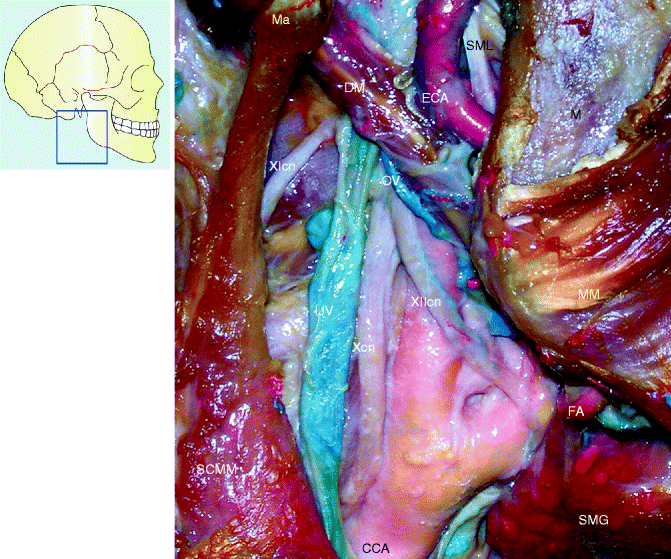

Fig. 1.9
Upper laterocervical and parotid regions
CCA common carotid artery, DM digastric muscle, ECA external carotid artery, FA facial artery, IJV internal jugular vein, M mandible, Ma mastoid (tip), MM masseter muscle, OV occipital vein, SCMM sternocleidomastoid muscle, SMG submandibular gland, SML sphenomandibular ligament, Xcn vagus nerve, XIcn accessory nerve, XIIcn hypoglossal nerve
The internal carotid artery origins at the level of the carotid bifurcation. Two segments can be described. The proximal segment extends from the bifurcation to the point where the artery is crossed by the posterior belly of the digastric muscle (Beretta et al. 2006). The distal segment is from this point to the carotid canal at the skull base.
The hypoglossal nerve courses along the inferior aspect of the posterior belly of the digastric muscle and crosses both internal and external carotid artery.
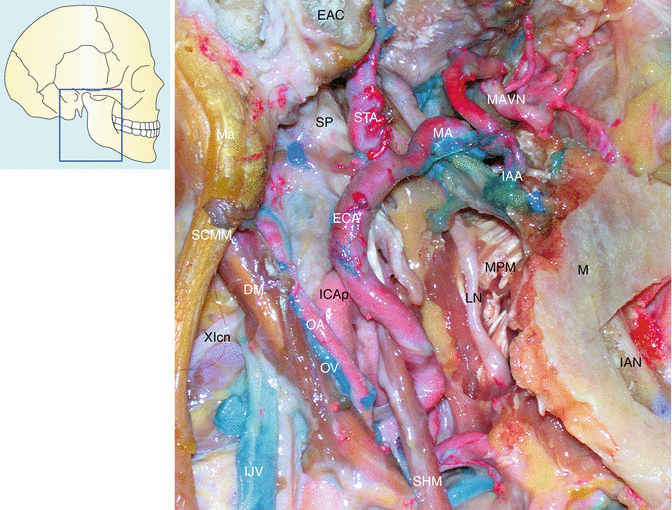

Fig. 1.10
Infratemporal, parapharyngeal, and upper laterocervical regions. The mandible has been partially cut, pushed forward and inferiorly, and the inferior alveolar nerve dissected in its own canal
DM digastric muscle, EAC external acoustic canal, ECA external carotid artery, IAA inferior alveolar artery, IAN inferior alveolar nerve, ICAp parapharyngeal portion of the internal carotid artery, IJV internal jugular vein, LN lingual nerve, M mandible, Ma mastoid, MA maxillary artery, MAVN maxillary artery vascular network, MPM medial pterygoid muscle, OA occipital artery, OV occipital vein, SCMM sternocleidomastoid muscle, SHM stylohyoid muscle, SP styloid process, STA superficial temporal artery, XIcn accessory nerve
The styloid apparatus separates the internal carotid artery from the external carotid artery. The stylohyoid muscle is the most lateral element of the styloid apparatus, while the stylopharyngeus the most medial.
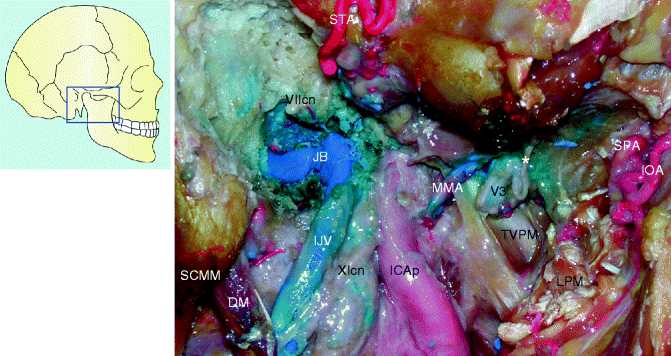
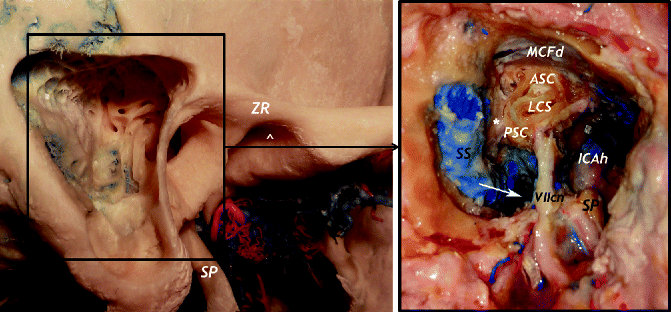
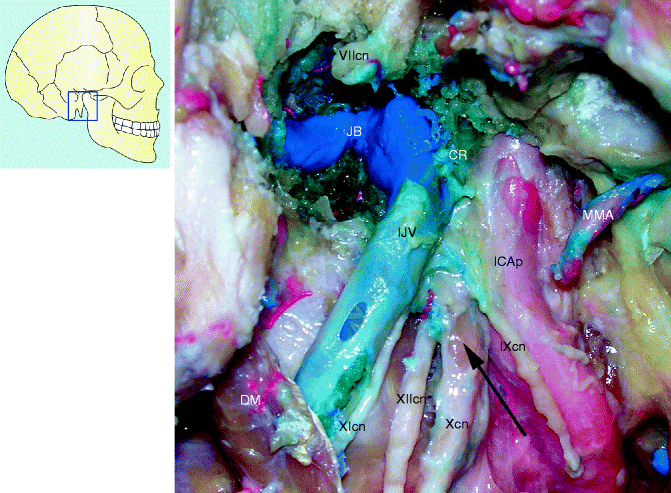

Fig. 1.11
Infratemporal fossa and jugular foramen exposure
DM digastric muscle, ICAp parapharyngeal portion of the internal carotid artery, IJV internal jugular vein, IOA infraorbital artery, LPM lateral pterygoid muscle, MMA middle meningeal artery, SCMM sternocleidomastoid muscle, SPA sphenopalatine artery, STA superficial temporal artery, TVPM tensor veli palatini muscle, V3 third branch of the trigeminal nerve, VIIcn facial nerve, XIcn accessory nerve, white asterisk branch for the middle cranial fossa dura

Fig. 1.12
Jugular foramen region: transpetrous exposure
ASC anterior semicircular canal, ICAh horizontal portion of the internal carotid artery, LSC lateral semicircular canal, MCFd dura of the middle cranial fossa, PSC posterior semicircular canal, SP styloid process, SS sigmoid sinus, ZR zygomatic root, VIIcn facial nerve, white arrow jugular tubercle, white asterisk endolymphatic sac, white arrowhead glenoid fossa

Fig. 1.13
Jugular foramen region
CR carotid ridge, DM digastric muscle (posterior belly), ICAp parapharyngeal portion of the internal carotid artery, IJV internal jugular vein, JB jugular bulb, MMA middle meningeal artery, VIIcn facial nerve, IX glossopharyngeal nerve, X vagus nerve, XI accessory nerve, XII hypoglossal nerve, black arrow inferior ganglion of vagus nerve
The jugular bulb lies beneath the floor of the middle ear cavity (Roche et al. 2008). It can be of variable shape and size. All the lower cranial nerves (LCNs) exit the foramen anteromedially to the jugular bulb, separated from it by connective tissue. The superior ganglion of the vagus nerve is within the jugular foramen (JF). At the level of the intraforaminal course, there is a strict connection between the LCNs. The vagus nerve exits the JF vertically, behind IXcn and ICAp (Roche et al. 2008) and gives its inferior ganglion on the outer skull base surface. The accessory nerve lies immediately lateral to the vagus nerve.
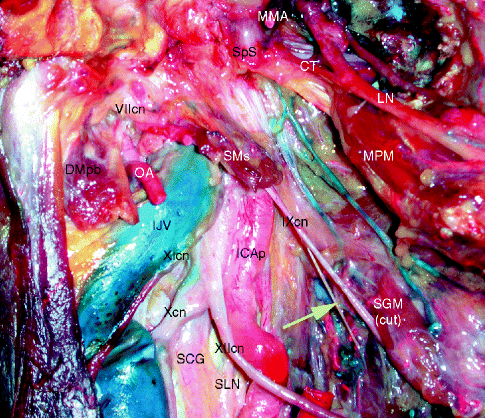

Fig. 1.14
Upper parapharyngeal region below the jugular foramen. Note that the styloid muscles covering the parapharyngeal vessels are partially removed
CT chorda tympani, DMpb posterior belly of the digastric muscle, ICAp parapharyngeal portion of the internal carotid artery, IJV internal jugular vein, LN lingual nerve, MMA middle meningeal artery, MPM medial pterygoid muscle, OA occipital artery, SCG superior cervical ganglion (sympathetic), SGM styloglossus muscle, SLN superior laryngeal nerve, SMs styloid muscles, SpS spine of the sphenoid, VIIcn facial nerve, IXcn glossopharyngeal nerve, Xcn vagus nerve, XIcn accessory nerve, XIIcn hypoglossal nerve, yellow arrow pharyngeal branch of IX cranial nerve
The lower cranial nerves and the IJV present an intimate relationship with the transverse process of C1. In its upper segment, the IJV lies behind the ICAp on the levator scapulae (Janfaza and Fabian 2001b). The stylopharyngeus muscle and the styloid process separate the IJV from the parotid gland. Usually, the pharyngeal branch of cranial nerve IX runs anteriorly between the internal and external carotid arteries inferior to the main trunk of cranial nerve IX (Janfaza and Fabian 2001b).
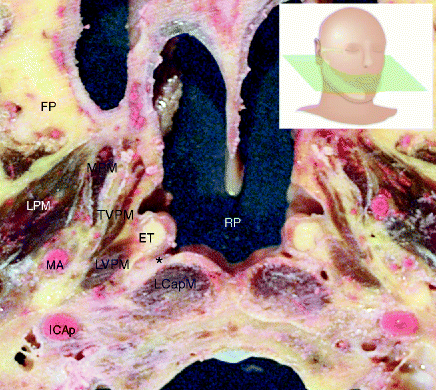

Fig. 1.15
Axial view of the parapharyngeal region
ET eustachian tube, FP fat pad, ICAp parapharyngeal portion of the internal carotid artery, LCapM longus capitis muscle, LPM lateral pterygoid muscle, LVPM levator veli palatini muscle, MA maxillary artery, MPM medial pterygoid muscle, RP rhinopharynx, TVPM tensor veli palatini muscle, black asterisk Rosenmuller’s fossa
The upper parapharyngeal region is demonstrated. In particular, the position of the muscles is evident. The prestyloid compartment is now identified as the true parapharyngeal space, while the poststyloid compartment is now named the carotid space (Stambuk and Patel 2008). The prestyloid space is separated from the poststyloid regions by means of a fascial layer connecting the styloid process to the pharyngeal wall. The true parapharyngeal space contains the tensor veli palatine muscle and the tensor-styloid fascia, which reflects from the TVPM and reaches the pharyngeal wall (Janfaza et al. 2001).
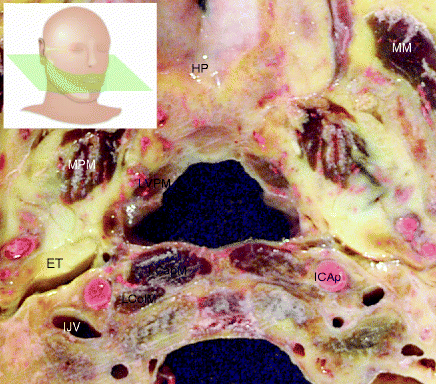
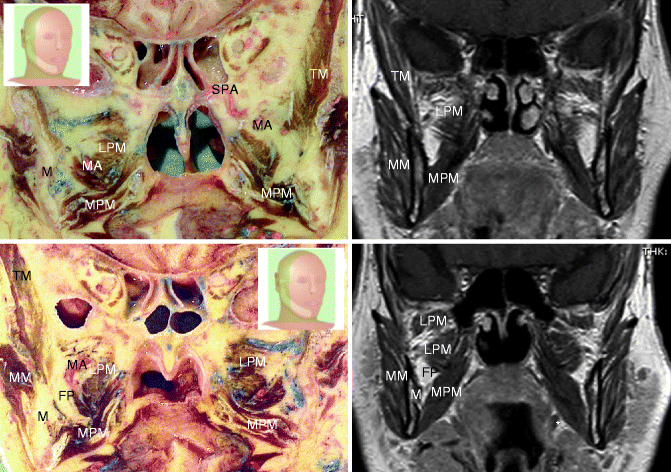
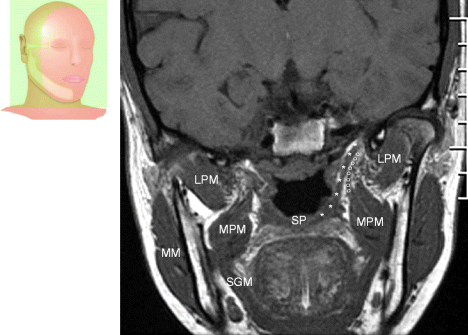

Fig. 1.16
Axial view of the parapharyngeal region (more caudally in respect to the previous image)
ET eustachian tube, HP hard palate, ICAp parapharyngeal portion of the internal carotid artery, IJV internal jugular vein, LCapM longus capitis muscle, LColM longus colli muscle, LVPM levator veli palatini muscle, MM masseter muscle, MPM medial pterygoid muscle

Fig. 1.17
Coronal views of the infratemporal fossa
FP fat pad, LPM lateral pterygoid muscle, M mandible, MA maxillary artery, MM masseter muscle, MPM medial pterygoid muscle, SPA sphenopalatine artery, TM temporal muscle

Fig. 1.18




Coronal view of the infratemporal fossa
LPM lateral pterygoid muscle, MM masseter muscle, MPM medial pterygoid muscle, SGM styloglossus muscle, SP soft palate, white asterisks levator veli palatini muscle, white circles tensor veli palatini muscle
Stay updated, free articles. Join our Telegram channel

Full access? Get Clinical Tree


